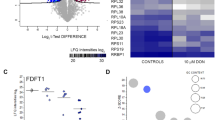Abstract
Deoxynivalenol (DON), a typical mycotoxin, is a substance that is biosynthesized mainly by the Fusarium species. It is usually found in wheat and other grains grown in the field. When it enters the human body, it causes severe diarrhea, abdominal pain, vomiting, and even death. In addition, DON is known to induce inflammation of the small and large intestine, and is also associated with the occurrence of cancer. However, until recently, the effects of DON on the human skin were unknown. To investigate how DON affects HaCaT, human immortalized keratinocytes, we used CCK-8 assay and a quantitative real-time RT-PCR method to detect changes in the expression of tight junctions and skin cell regulatory proteins. The CCK-8 assay was performed to determine the growth inhibitory concentration of keratinocytes by DON. DON affected the cell survival rate from 1 μM in a concentration dependent manner, with the minimum set as 1 μM and the maximum as 4 μM for all experiments. DON inhibited the mRNA expression of filaggrin by up to 71% and SERPINA1 up to 75%. The expression of AQP3 was reduced by up to 93% compared to the untreated control group. This may cause problems in the pH control function of the skin and weaken the function of moisturizing. In addition, in the presence of DON, the gene expression of claudin 1 and claudin 8, which are important proteins in the regulation of intercellular skin barrier, decreased by up to 47 and 80%, respectively. Snail/ Slug, suppressors of the claudin gene expression, each increased up to 625 and 974%, respectively. Also, the MMP9 gene increased by up to 515% in a concentrationdependent manner, perhaps causing a weakness of the barrier function of the skin. These results suggest that DON may causing the development of atopic skin by impairing the skin barrier and pH control of skin, as well as intestinal inflammation diseases. Therefore, particular attention should be paid to DON contamination during the development of cosmetic ingredients using grains.
Similar content being viewed by others
References
Gautam, P. and R. Dill-Macky (2012) Impact of moisture, host genetics and Fusarium graminearum isolates on Fusarium head blight development and trichothecene accumulation in spring wheat. Mycotoxin Res. 28: 45–58.
Pinton, P., J. P. Nougayrède, J. C. Del Rio, C. Moreno, D. E. Marin, L. Ferrier, A. P. Bracarense, M. Kolf-Clauw, and I. P. Oswald (2009) The food contaminant deoxynivalenol, decreases intestinal barrier permeability and reduces claudin expression. Toxicol. Appl. Pharmacol. 237: 41–48.
Van De Walle, J., T. Sergent, N. Piront, O. Toussaint, Y. J. Schneider, and Y. Larondelle (2010) Deoxynivalenol affects in vitro intestinal epithelial cell barrier integrity through inhibition of protein synthesis. Toxicol. Appl. Pharmacol. 245: 291–298.
Mishra, S., A. Tripathi, B. P. Chaudhari, P. D. Dwivedi, H. P. Pandey, and M. Das (2014) Deoxynivalenol induced mouse skin cell proliferation and inflammation via MAPK pathway. Toxicol. Appl. Pharmacol. 279: 186–197.
Elias, P. M. and G. K. Menon (1991) Structural and lipid biochemical correlates of the epidermal permeability barrier. Adv. Lipid Res. 24: 1–26.
Kubo, A., K. Nagao, and M. Amagai (2012) Epidermal barrier dysfunction and cutaneous sensitization in atopic diseases. J. Clin. Invest. 122: 440–506.
Scharschmidt, T. C., M. Q. Man, Y. Hatano, D. Crumrine, R. Gunathilake, J. P. Sundberg, B. S. Silva, T. M. Mauro, M. Hupe, S. Cho, Y. Wu, A. Celli, M. Schmuth, K. R. Feingold, and P. M. Elias (2009) Filaggrin deficiency confers a paracellular barrier abnormality that reduces inflammatory thresholds to irritants and haptens. J. Allergy Clin. Immunol. 124: 496–506.
Harding, C. R., A. Watkinson, A. V. Rawlings, and I. R. Scott (2000) Dry skin, moisturization and corneodesmolysis. Int. J. Cosmet. Sci. 22: 21–52.
Agre, P., L. S. King, Yasui, M., W. B. Guggino, O. P. Ottersen, Y. Fujiyoshi, A. Engel, and S. Nielsen (2002) Aquaporin water channels–from atomic structure to clinical medicine. J. Physiol. 542: 3–16.
Ishibashi, K., S. Hara, and S. Kondo (2009) Aquaporin water channels in mammals. Clin. Exp. Nephrol. 13: 107–117.
Furuse, M., M. Hata, K. Furuse, Y. Yoshida, A. Haratake, Y. Sugitani, T. Noda, A. Kubo, and S. Tsukita (2002) Claudin-based tight junctions are crucial for the mammalian epidermal barrier. J. Cell Biol. 156: 1099–1111.
Wang, H., K. Chao, S. C. Ng, A. H. Bai, Q. Yu, J. Yu, M. Li, Y. Cui, M. Chen, J. F. Hu, and S. Zhang (2016) Pro-inflammatory miR-223 mediates the cross-talk between the IL23 pathway and the intestinal barrier in inflammatory bowel disease. Genome Biol. 17: 58–72.
Hachem, J. P., D. Crumrine, J. Fluhr, B. E. Brown, K. R. Feingold, and P. M. Elias (2003) pH directly regulates epidermal permeability barrier homeostasis, and stratum corneum integrity/cohesion. J. Invest. Dermatol. 121: 345–353.
Heissig, B., K. Hattori, S. Dias, M. Friedrich, B. Ferris, N. R. Hackett, R. G. Crystal, P. Besmer, D. Lyden, M. A. Moore, Z. Werb, and S. Rafii (2002) Recruitment of stem and progenitor cells from the bone marrow niche requires MMP-9 mediated release of kit-ligand. Cell. 109: 625–637.
Vermeer, P. D., J. Denker, M. Estin, T. O. Moninger, S. Keshavjee, P. Karp, J. N. Kline, and J. Zabner (2009) MMP9 modulates tight junction integrity and cell viability in human airway epithelia. Am. J. Physiol. Lung Cell Mol. Physiol. 296: 751–762.
Martínez-Estrada, O.M., A. Cullerés, F. X. Soriano, H. Peinado, V. Bolós, F. O. Martínez, M. Reina, A. Cano, M. Fabre, and S. Vilaró (2006) The transcription factors Slug and Snail act as repressors of Claudin-1 expression in epithelial cells. Biochem. J. 394: 449–457.
Author information
Authors and Affiliations
Corresponding author
Rights and permissions
About this article
Cite this article
Cho, U.M., Choi, J.H. & Hwang, H.S. Deoxynivalenol impair skin barrier function through the down regulation of filaggrin and claudin 1/8 in HaCaT keratinocyte. Biotechnol Bioproc E 22, 693–699 (2017). https://doi.org/10.1007/s12257-017-0367-x
Received:
Revised:
Accepted:
Published:
Issue Date:
DOI: https://doi.org/10.1007/s12257-017-0367-x




